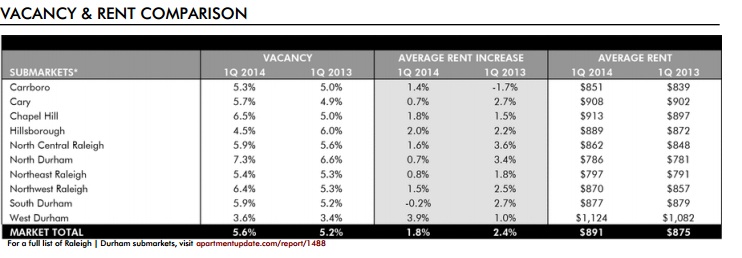The greater Raleigh, N.C., market appears to be getting back on its feet again, which is good news for rental property owners.
Driven by the growth of government expansion and technology companies, the Raleigh-Durham area added 14,400 new jobs in the first half of this year, representing a 1.8% increase over the same period a year earlier, according to a report on the website Commercial Property Executive.
Equally important, the market’s median household income increased by 4.4% to $59,030.
These gains have been a positive impetus for new apartment construction and what owners can charge renters, albeit somewhat counter-intuitively. The number of apartments available has been falling since late 2013. However, completions of new apartments exceed demand, and multifamily permits have increased by 15% since the beginning of the year to an annualized rate of 7,540.
Still, the average monthly rent in the Raleigh-Cary area is up 1.2%, according to new research by Axiometrics. “Job growth continues to be strong, and new household formation is resulting in the absorption of new units,” Jay Denton, Axiometrics’ senior vice president of research and analytics, told the Triangle Business Journal.
The average rents for apartment communities open at least a year was $920 per month in the third quarter, compared to $899 in the same quarter in 2013, according to Axiometrics.
Related Stories
| Jan 7, 2015
How you can help improve the way building information is shared
PDFs are the de facto format for digital construction documentation. Yet, there is no set standard for how to produce PDFs for a project, writes Skanska's Kyle Hughes.
Smart Buildings | Jan 7, 2015
Best practices for urban infill development: Embrace the region's character, master the pedestrian experience
If an urban building isn’t grounded in the local region’s character, it will end up feeling generic and out-of-place. To do urban infill the right way, it’s essential to slow down and pay proper attention to the context of an urban environment, writes GS&P's Joe Bucher.
| Jan 6, 2015
Construction permits exceeded $2 billion in Minneapolis in 2014
Two major projects—a new stadium for the Minnesota Vikings NFL team and the city’s Downtown East redevelopment—accounted for about half of the total worth of the permits issued.
| Jan 6, 2015
Snøhetta unveils design proposal of the Barack Obama Presidential Center Library for the University of Hawaii
The plan by Snøhetta and WCIT Architecture features a building that appears square from the outside, but opens at one corner into a rounded courtyard with a pool, Dezeen reports.
| Jan 5, 2015
Another billionaire sports club owner plans to build a football stadium in Los Angeles
Kroenke Group is the latest in a series of high-profile investors that want to bring back pro football to the City of Lights.
| Jan 5, 2015
Beyond training: How locker rooms are becoming more like living rooms
Despite having common elements—lockers for personal gear and high-quality sound systems—the real challenge when designing locker rooms is creating a space that reflects the attitude of the team, writes SRG Partnership's Aaron Pleskac.
| Jan 2, 2015
Illustrations of classic architecture bring in the new year with style
New York-based designer Xinran Ma has illustrated a New Year's greeting card that assembles pieces of various brutalist and modernist architecture.
| Jan 2, 2015
Construction put in place enjoyed healthy gains in 2014
Construction consultant FMI foresees—with some caveats—continuing growth in the office, lodging, and manufacturing sectors. But funding uncertainties raise red flags in education and healthcare.
| Dec 30, 2014
A simplified arena concept for NBA’s Warriors creates interest
The Golden State Warriors, currently the team with the best record in the National Basketball Association, looks like it could finally get a new arena.
| Dec 30, 2014
The future of healthcare facilities: new products, changing delivery models, and strategic relationships
Healthcare continues to shift toward Madison Avenue and Silicon Valley as it revamps business practices to focus on consumerism and efficiency, writes CBRE Healthcare's Patrick Duke.
















